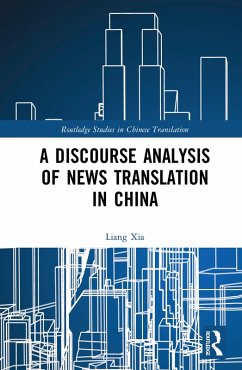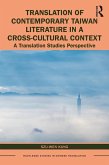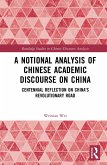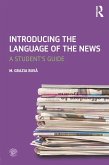A Discourse Analysis of News Translation in China (eBook, PDF)


Alle Infos zum eBook verschenken

A Discourse Analysis of News Translation in China (eBook, PDF)
- Format: PDF
- Merkliste
- Auf die Merkliste
- Bewerten Bewerten
- Teilen
- Produkt teilen
- Produkterinnerung
- Produkterinnerung

Hier können Sie sich einloggen

Bitte loggen Sie sich zunächst in Ihr Kundenkonto ein oder registrieren Sie sich bei bücher.de, um das eBook-Abo tolino select nutzen zu können.
A Discourse Analysis of News Translation in China offers hitherto underexplored inroads into Chinese media through insider perspectives on a unique Chinese newspaper, Cankao Xiaoxia which not only is the largest circulating newspaper in China but is also unique in that its news consists entirely of stories translated from foreign news sources.
The size of the publication, the unique nature of the publication, and the view from the inside of such an organization gathered through interviews with its employees give this proposed book a highly unique perspective that will inform our understanding of the workings of Chinese media in important ways.…mehr
- Geräte: PC
- mit Kopierschutz
- eBook Hilfe
![News Framing through English-Chinese Translation (eBook, PDF) News Framing through English-Chinese Translation (eBook, PDF)]() Nancy LiuNews Framing through English-Chinese Translation (eBook, PDF)42,95 €
Nancy LiuNews Framing through English-Chinese Translation (eBook, PDF)42,95 €![Analysing Representations of Social Media in European News Media Discourse (eBook, PDF) Analysing Representations of Social Media in European News Media Discourse (eBook, PDF)]() Christine DevelotteAnalysing Representations of Social Media in European News Media Discourse (eBook, PDF)39,95 €
Christine DevelotteAnalysing Representations of Social Media in European News Media Discourse (eBook, PDF)39,95 €![Translation in Global News (eBook, PDF) Translation in Global News (eBook, PDF)]() Esperanca BielsaTranslation in Global News (eBook, PDF)46,95 €
Esperanca BielsaTranslation in Global News (eBook, PDF)46,95 €![Translation of Contemporary Taiwan Literature in a Cross-Cultural Context (eBook, PDF) Translation of Contemporary Taiwan Literature in a Cross-Cultural Context (eBook, PDF)]() Szu-Wen KungTranslation of Contemporary Taiwan Literature in a Cross-Cultural Context (eBook, PDF)37,95 €
Szu-Wen KungTranslation of Contemporary Taiwan Literature in a Cross-Cultural Context (eBook, PDF)37,95 €![Arabic Translation Across Discourses (eBook, PDF) Arabic Translation Across Discourses (eBook, PDF)]() Arabic Translation Across Discourses (eBook, PDF)39,95 €
Arabic Translation Across Discourses (eBook, PDF)39,95 €![A Notional Analysis of Chinese Academic Discourse on China (eBook, PDF) A Notional Analysis of Chinese Academic Discourse on China (eBook, PDF)]() Weixiao WeiA Notional Analysis of Chinese Academic Discourse on China (eBook, PDF)42,95 €
Weixiao WeiA Notional Analysis of Chinese Academic Discourse on China (eBook, PDF)42,95 €![Introducing the Language of the News (eBook, PDF) Introducing the Language of the News (eBook, PDF)]() M. Grazia BusaIntroducing the Language of the News (eBook, PDF)38,95 €
M. Grazia BusaIntroducing the Language of the News (eBook, PDF)38,95 €-
-
-
The size of the publication, the unique nature of the publication, and the view from the inside of such an organization gathered through interviews with its employees give this proposed book a highly unique perspective that will inform our understanding of the workings of Chinese media in important ways.
Dieser Download kann aus rechtlichen Gründen nur mit Rechnungsadresse in A, B, BG, CY, CZ, D, DK, EW, E, FIN, F, GR, HR, H, IRL, I, LT, L, LR, M, NL, PL, P, R, S, SLO, SK ausgeliefert werden.
- Produktdetails
- Verlag: Taylor & Francis eBooks
- Seitenzahl: 238
- Erscheinungstermin: 21. Januar 2019
- Englisch
- ISBN-13: 9781351021456
- Artikelnr.: 56890142
- Verlag: Taylor & Francis eBooks
- Seitenzahl: 238
- Erscheinungstermin: 21. Januar 2019
- Englisch
- ISBN-13: 9781351021456
- Artikelnr.: 56890142
- Herstellerkennzeichnung Die Herstellerinformationen sind derzeit nicht verfügbar.
LIST OF TABLES
LIST OF ABBREVIATIONS
ACKNOWLEDGEMENTS
Chapter 1 Introduction
1.1 The nature of the investigation
1.2 Cankao Xiaoxi
1.2.1 Current format and key features
1.2.2 The history of the Cankao Xiaoxi
1.3 Purpose and significance
1.4 The structure and organisation
Chapter 2 News translation
2.1 Introduction
2.2 The key developments in Translation Studies
2.2.1 From equivalence to Skopos
2.2.2 From translator invisible to translator visible
2.2.3 From linguistic-oriented to cultural-oriented
2.3 Translation as manipulation
2.4 Translation in news
2.4.1 News making through translation
2.4.2 Features of news translation
2.4.3 Gatekeeping process in news translation
2.4.4 Previous studies on Cankao Xiaoxi
2.5 Summary
Chapter 3 Critical discourse analysis and the present study
3.1 Introduction
3.2 General principles of critical discourse analysis
3.3 Outline of Fairclough's CDA and conceptualisation of power
3.4 Critical discourse analysis and news translation
3.5 Summary
Chapter 4 Methods and data
4.1 Introduction
4.2 Research questions
4.3 Performing the research
4.4 The data for the study
4.5 Methodological considerations
4.6 Summary
Chapter 5 News translation product in Cankao Xiaoxi
5.1 Introduction
5.2 Translation at the lexical level
5.2.1 Addition
5.2.2 Subtraction
5.2.3 Alteration
5.3 Translation above the lexical level
5.4 Summary
Chapter 6 Translation process and translators in Cankao Xiaoxi
6.1 Introduction
6.2 Translation as a process
6.2.1 Source news selection
6.2.2 Source news translation
6.2.3 Translation editing
6.3 Translators in the institutional process
6.3.1 Becoming a translator in Cankao Xiaoxi
6.3.2 Working as a translator in Cankao Xiaoxi
6.3.3 Targeted translators in Cankao Xiaoxi
6.4 Summary
Chapter 7 News translation practice in sociocultural China
7.1 Introduction
7.2 Historical development of Party media in China
7.3 Current situation of Party newspapers in China
7.4 The use of Party media by Chinese government
7.5 Institutional practice in Cankao Xiaoxi
7.5.1 The mission
7.5.2 The operation of censorship
7.5.3 The distribution of Cankao Xiaoxi's output
7.5.4 Its impact on its audience
7.5.5 Moving towards digitisation
7.6 Summary
Chapter 8 Conclusion
8.1 Concluding summary
8.2 Discussion
8.2.1 Manipulation in news translation
8.2.2 Institutionalisation in news translation
8.2.3 Power relations in news translation
8.3 Directions for further research
REFERENCES
APPENDIX A INTERVIEW QUESTIONS
APPENDIX B SUMMARY OF OCCURRENCES
APPENDIX C SAMPLE ST-TT
Appendix C-1
Appendix C-2
Appendix C-3
Appendix C-4
Appendix C-5
Appendix C-6
Appendix C-7
Appendix C-8
Appendix C-9
Appendix C-10
Appendix C-11
Index
LIST OF TABLES
LIST OF ABBREVIATIONS
ACKNOWLEDGEMENTS
Chapter 1 Introduction
1.1 The nature of the investigation
1.2 Cankao Xiaoxi
1.2.1 Current format and key features
1.2.2 The history of the Cankao Xiaoxi
1.3 Purpose and significance
1.4 The structure and organisation
Chapter 2 News translation
2.1 Introduction
2.2 The key developments in Translation Studies
2.2.1 From equivalence to Skopos
2.2.2 From translator invisible to translator visible
2.2.3 From linguistic-oriented to cultural-oriented
2.3 Translation as manipulation
2.4 Translation in news
2.4.1 News making through translation
2.4.2 Features of news translation
2.4.3 Gatekeeping process in news translation
2.4.4 Previous studies on Cankao Xiaoxi
2.5 Summary
Chapter 3 Critical discourse analysis and the present study
3.1 Introduction
3.2 General principles of critical discourse analysis
3.3 Outline of Fairclough's CDA and conceptualisation of power
3.4 Critical discourse analysis and news translation
3.5 Summary
Chapter 4 Methods and data
4.1 Introduction
4.2 Research questions
4.3 Performing the research
4.4 The data for the study
4.5 Methodological considerations
4.6 Summary
Chapter 5 News translation product in Cankao Xiaoxi
5.1 Introduction
5.2 Translation at the lexical level
5.2.1 Addition
5.2.2 Subtraction
5.2.3 Alteration
5.3 Translation above the lexical level
5.4 Summary
Chapter 6 Translation process and translators in Cankao Xiaoxi
6.1 Introduction
6.2 Translation as a process
6.2.1 Source news selection
6.2.2 Source news translation
6.2.3 Translation editing
6.3 Translators in the institutional process
6.3.1 Becoming a translator in Cankao Xiaoxi
6.3.2 Working as a translator in Cankao Xiaoxi
6.3.3 Targeted translators in Cankao Xiaoxi
6.4 Summary
Chapter 7 News translation practice in sociocultural China
7.1 Introduction
7.2 Historical development of Party media in China
7.3 Current situation of Party newspapers in China
7.4 The use of Party media by Chinese government
7.5 Institutional practice in Cankao Xiaoxi
7.5.1 The mission
7.5.2 The operation of censorship
7.5.3 The distribution of Cankao Xiaoxi's output
7.5.4 Its impact on its audience
7.5.5 Moving towards digitisation
7.6 Summary
Chapter 8 Conclusion
8.1 Concluding summary
8.2 Discussion
8.2.1 Manipulation in news translation
8.2.2 Institutionalisation in news translation
8.2.3 Power relations in news translation
8.3 Directions for further research
REFERENCES
APPENDIX A INTERVIEW QUESTIONS
APPENDIX B SUMMARY OF OCCURRENCES
APPENDIX C SAMPLE ST-TT
Appendix C-1
Appendix C-2
Appendix C-3
Appendix C-4
Appendix C-5
Appendix C-6
Appendix C-7
Appendix C-8
Appendix C-9
Appendix C-10
Appendix C-11
Index







